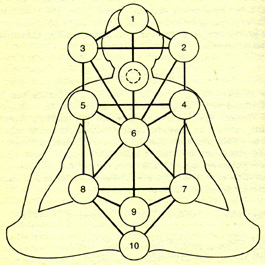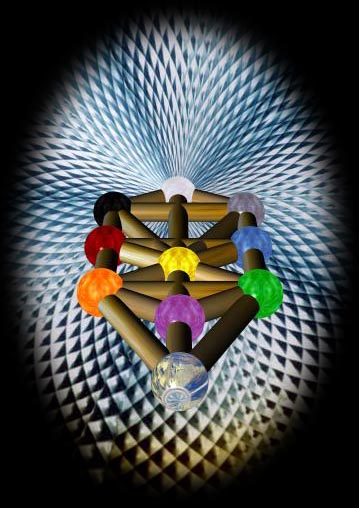 The Interactive Qabala
The Interactive Qabala
A Hyperpædia of En Sof Aur
OVERVIEW
including
A brief history of Kabala, charts of the tree, ideas about its meaning, and a bibliography/suggested reading list.
Eliphas Levi said the Tarot is a "Lottery of thoughts;" another way to see it is as a collection of dream images or archetypes. The interlocking of Tarot and Qabala creates a mnemonic (aiding the memory) device for bringing order to these symbols.
The Tree of the Sephirot
"Sepher," in Hebrew, means "book," or "number." It is related to our words "sphere," "cipher," and "sapphire." In addition, "Sippur" means to teach, tell a story, or impart.
The 'tree of books' was developed by Jewish mystics first in the "Sephir Yetzirah," (Book of Formation) between 100 and 600 A.D.; and then more thoroughly in the "Sefir ha Zohar," (Book of Splendor) written between 1280 and 1286 by Moses ben Shem Tov de Leon in Guadalajara, Spain.
Qabala originated in Judaism, but has been adapted to numerous other religious systems. There were Christian Kabalists, most notably the mystic Jacob Boehme (1575-1624), whose writings influenced the nineteenth-century magicians who led the Golden Dawn, which became known of as the "Western Mystery Tradition." The interpretations in these pages derive from a combination of the Western Mystery tradition, Judaic tradition, and contemporary astrological analysis. Complex genealogies trace varying threads and histories of Qabalah, also often rendered as Kaballah, Cabala, et al.
The fact is, faithful of any religion, or even total atheists, can find Qabala useful. Even the most hardened existentialists have to admit to mental states; things like ambition, enthusiasm, awe, gratitude - all conditions mapped in the Tree of Life.
Qabala (Hebrew verb root QBL - to receive or accept) is a system of thought - a way to correlate a variety of archetypes, each symbolizing a different aspect of living. It correlates a multiplicity of different approaches, widely separated from one another and sometimes completely contradictory. Psychology, Tarot, mythology, theosopy, dreamworking, astrology, numerology, poetry, and geometry all harmonize in the Tree of Life.
The Tree is a map of personal energies and thought. It is a "filing system" for our mythologies, histories, dream archetypes, and more. It is a way for us to visualize the un-vizualizable, to describe the ineffable mystery. With our limited consciousness we must accept that any such description can only be metaphor, only an approximation.
It is a way to bring balance and harmony into life. In the sephirot, one can see where imbalances have developed, and can do 'pathwork' or 'active imagination' rituals and exercises to bring balance.
Qabala is relatively new, though the notion that it is a reconstruction of the lost knowledge of the ancients adds to its appeal. Some say the 10 commandments given to Moses on Mount Sinai are the same ten Sephirot in the Tree of Life. Egypt is also included in the patronage. Either way, it is a valid and engaging meditation device.
Yet another way of seeing the Tree is as a way to describe "God." It's well known that our minds are incapable of defining or describing "God," so the Etz Chaim begins to provide a glimpse, or a map, of that mystery we want to know and contemplate.
Spheres and Paths
Each of the ten spheres (also called 'paths') is connected by at least three of the 22 paths. Each of the paths is identified with A) a letter in the Hebrew alphabet, B) one of the 22 major Tarot trumps, C) a Zodiacal sign or body, and D) any number of other mnemonic triggers, like fragrances, metals, gems, magical weapons, animals, Egyptian, Nordic, or Greek gods. There is even a system for dividing the Lord's Prayer into the ten Sephirot.
The spheres are static psychic energy, while the paths are dynamic psychic energy. To make an analogy to language, we could say that the Sephirot are nouns, and the paths are verbs.
Major Trumps - Triunfi - Major Arcana
The connection of the 22 'Major Trumps' of Tarot to Qabala is controversial. It was first concieved by Eliphas Levi, in the nineteenth century, and is definitely a non-Jewish phenomenon. The cards were originally used for games, and the adoption of the images by Qabalists is similar to psychologists' Rorschach ink blots. As mnemonic devices, Tarot images are optimal.
Differing ideas about the path/card attributions switch around certain cards - here the system is that of the Order of the Golden Dawn.
In the context of Qabala, the Tarot cards are NOT used for 'divination,' or fortune telling. The Tarot cards can be seen as 'scenarios,' or 'dream states,' that characterize the particular lesson of that path. The images in the cards remind and make tangible the particular transformation being wrought.
Using the Interactive Tree
In the frame to the left, click on "Reveal" to show the correspondences drawn on the tree. To see maps of the letters, signs and bodies, click on the "Aleph." On any of the trees or glyphs, you can click on the sphere, path, or glyph to see the Tarot trump and other details in this frame. If you don't see a frame to the left, click Here.
It is usually advisable to begin and end Qabala meditations in Malchut, or Key 21to stay grounded. Not doing so can lead to a terrifying unrootedness.
Spheres of Emanation
Keter is the first receptacle of pure essence from the infinite; called "en Sof Aur," (Light Without End). As the light works its way to our world, Malchut, it passes through the intervening spheres. The process of emanation is as if one candle were lit from another without the Emanator being diminished. These stones of fire show a map of consciousness, in the macrocosmos, and the microcosmos.
Before emanation, creating the possibility of a universe, is Tzimtum, the "Great Contraction."
Realms and Pillars



